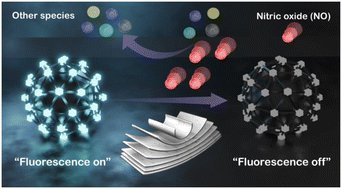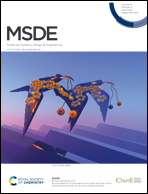Post engineering of a chemically stable MOF for selective and sensitive sensing of nitric oxide†
Abstract
A hydrolytically stable luminous metal–organic framework (MOF) sensor was strategically designed for precise dual phase recognition of biologically relevant yet toxic nitric oxide (NO). Judicious utilization of the enabling post-synthetic modification (PSM) technology in chemically robust MOF-808 yielded amine decorated and highly luminescent PABA@MOF-808. The thus-prepared functionalized sensory probe was employed for sensitive detection of NO in both aqueous and gaseous phases in a selective manner. An exclusive fluorogenic “turn-off” response was observed for NO over other relevant reactive nitrogen and oxygen species (RNS and ROS) with high quenching efficiency via deamination reaction as the modus operandi. The potency of PABA@MOF-808 toward accurate detection of NO was further punctuated by a high Ksv value (6.10 × 103 M−1) and an exceptional limit of detection (LOD) value of 0.715 μM (21.45 ppb). Additionally, the underlying sensing mechanism was disseminated with the help of experimental data as well as theoretical insights. Pertaining to processability toward practical implementation, a flexible self-standing mixed-matrix membrane (MMM) of PABA@MOF-808 was further devised for efficient sensing of NO in both water medium and vapor phase.

- This article is part of the themed collection: Molecular Engineering in MOFs: Beyond Reticular Chemistry


 Please wait while we load your content...
Please wait while we load your content...